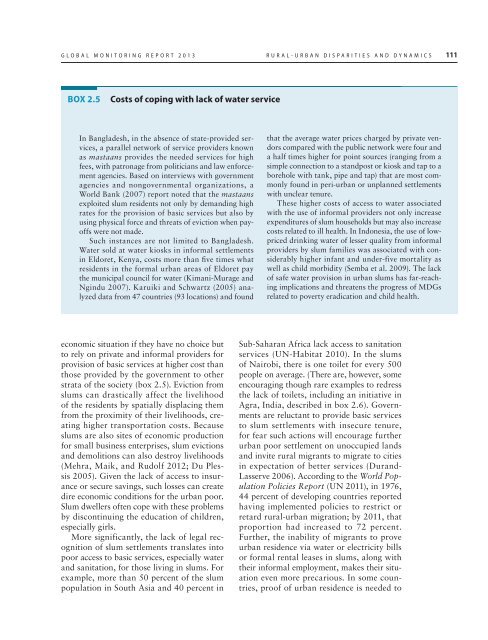rural-urban dynamics_report.pdf - Khazar University
rural-urban dynamics_report.pdf - Khazar University
rural-urban dynamics_report.pdf - Khazar University
Create successful ePaper yourself
Turn your PDF publications into a flip-book with our unique Google optimized e-Paper software.
GLOBAL MONITORING REPORT 2013 RURAL-URBAN DISPARITIES AND DYNAMICS 111<br />
BOX 2.5<br />
Costs of coping with lack of water service<br />
In Bangladesh, in the absence of state-provided services,<br />
a parallel network of service providers known<br />
as mastaans provides the needed services for high<br />
fees, with patronage from politicians and law enforcement<br />
agencies. Based on interviews with government<br />
agencies and nongovernmental organizations, a<br />
World Bank (2007) <strong>report</strong> noted that the mastaans<br />
exploited slum residents not only by demanding high<br />
rates for the provision of basic services but also by<br />
using physical force and threats of eviction when payoffs<br />
were not made.<br />
Such instances are not limited to Bangladesh.<br />
Water sold at water kiosks in informal settlements<br />
in Eldoret, Kenya, costs more than five times what<br />
residents in the formal <strong>urban</strong> areas of Eldoret pay<br />
the municipal council for water (Kimani-Murage and<br />
Ngindu 2007). Karuiki and Schwartz (2005) analyzed<br />
data from 47 countries (93 locations) and found<br />
that the average water prices charged by private vendors<br />
compared with the public network were four and<br />
a half times higher for point sources (ranging from a<br />
simple connection to a standpost or kiosk and tap to a<br />
borehole with tank, pipe and tap) that are most commonly<br />
found in peri-<strong>urban</strong> or unplanned settlements<br />
with unclear tenure.<br />
These higher costs of access to water associated<br />
with the use of informal providers not only increase<br />
expenditures of slum households but may also increase<br />
costs related to ill health. In Indonesia, the use of lowpriced<br />
drinking water of lesser quality from informal<br />
providers by slum families was associated with considerably<br />
higher infant and under-five mortality as<br />
well as child morbidity (Semba et al. 2009). The lack<br />
of safe water provision in <strong>urban</strong> slums has far-reaching<br />
implications and threatens the progress of MDGs<br />
related to poverty eradication and child health.<br />
economic situation if they have no choice but<br />
to rely on private and informal providers for<br />
provision of basic services at higher cost than<br />
those provided by the government to other<br />
strata of the society (box 2.5). Eviction from<br />
slums can drastically affect the livelihood<br />
of the residents by spatially displacing them<br />
from the proximity of their livelihoods, creating<br />
higher transportation costs. Because<br />
slums are also sites of economic production<br />
for small business enterprises, slum evictions<br />
and demolitions can also destroy livelihoods<br />
(Mehra, Maik, and Rudolf 2012; Du Plessis<br />
2005). Given the lack of access to insurance<br />
or secure savings, such losses can create<br />
dire economic conditions for the <strong>urban</strong> poor.<br />
Slum dwellers often cope with these problems<br />
by discontinuing the education of children,<br />
especially girls.<br />
More significantly, the lack of legal recognition<br />
of slum settlements translates into<br />
poor access to basic services, especially water<br />
and sanitation, for those living in slums. For<br />
example, more than 50 percent of the slum<br />
population in South Asia and 40 percent in<br />
Sub-Saharan Africa lack access to sanitation<br />
services (UN-Habitat 2010). In the slums<br />
of Nairobi, there is one toilet for every 500<br />
people on average. (There are, however, some<br />
encouraging though rare examples to redress<br />
the lack of toilets, including an initiative in<br />
Agra, India, described in box 2.6). Governments<br />
are reluctant to provide basic services<br />
to slum settlements with insecure tenure,<br />
for fear such actions will encourage further<br />
<strong>urban</strong> poor settlement on unoccupied lands<br />
and invite <strong>rural</strong> migrants to migrate to cities<br />
in expectation of better services (Durand-<br />
Lasserve 2006). According to the World Population<br />
Policies Report (UN 2011), in 1976,<br />
44 percent of developing countries <strong>report</strong>ed<br />
having implemented policies to restrict or<br />
retard <strong>rural</strong>-<strong>urban</strong> migration; by 2011, that<br />
proportion had increased to 72 percent.<br />
Further, the inability of migrants to prove<br />
<strong>urban</strong> residence via water or electricity bills<br />
or formal rental leases in slums, along with<br />
their informal employment, makes their situation<br />
even more precarious. In some countries,<br />
proof of <strong>urban</strong> residence is needed to

















